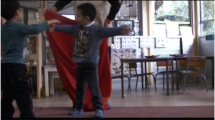Abstract
This paper examines the relationship between children's use of metaphors and their mental models concerning the ozone layer and the ozone layer depletion. Our study was based on semistructured, individual interviews with primary school Greek pupils. The analysis of data pointed to the construction of a limited number of models concerning the role of the ozone layer and the process of its depletion. A parallel analysis of the transcripts focused on the metaphorical statements pupils used while discussing the same issues. These statements were classified in categories such as persons, substances, and objects (containers, dividing surfaces, absorbing or reflecting surfaces, or holes). The results of the two dimensions of the analysis were correlated. It is found that there exist correlations between the ontological basis of metaphors and the particular models children use in order to understand and explain the role and depletion of the ozone layer. Thus, metaphors can be used as educational tools, so as to enhance understanding in the case of the ozone layer and its depletion.
Similar content being viewed by others
References
Black, M. (1979). More about metaphor. In A. Ortony (Ed.),Metaphor and thought (pp. 19–43). New York: Cambridge University Press.
Blalock, H. M. (1979).Social statistics. New York: McGraw-Hill.
Christidou, V. (1997).A study of primary students' conceptions regarding the ozone depletion and the greenhouse effect—Models, metaphors and epistemological obstacles. Unpublished PhD Thesis, University of Patras, Greece.
Christidou, V., & Koulaidis, V. (1996). Children's models of the ozone layer and depletion.Research in Science Education, 16(4), 421–436.
Cornell Way, E. (1991).Knowledge representation and metaphor. Dordrecht: Kluwer Academic Publishers.
Duit, R., & Glynn, S. (1995, April).Mental modeling. Paper presented at the Science Education Research in Europe Conference, Leeds, England.
Gentner, D., & Gentner, D. R. (1983). Flowing waters or teeming crowds: Mental models of electricity. In D. Gentner & A. Stevens (Eds.),Mental models (pp. 99–129). Hillsdale, NJ: Lawrence Erlbaum.
Goswami, U. (1992). Analogical reasoning in children. Hove: Lawrence Erlbaum.
Halford, G. S. (1993).Children's understanding-The development of mental models. Hillsdale, NJ: Lawrence Erlbaum.
Koulaidis, V., & Christidou, I. (1993). Children's misconceptions and cognitive strategies regarding the understanding of the ozone layer depletion.Proceedings of the Third International Seminar on Misconceptions and Educational Strategies in Science and Mathematics (pp. 329–358). Ithaca, NY: Misconceptions Trust.
Lakoff, G. (1987).Women, fire, and dangerous things-What categories reveal about the mind. Chicago: The University of Chicago Press.
Lakoff, G., & Johnson, M. (1980).Metaphors we live by. Chicago: The University of Chicago Press.
Mac Cormac, E. R. (1985).A cognitive theory of metaphor. Cambridge, MA: The MIT Press.
Martinand, J. L. (1982).Contribution à la charactérisation des objectifs de l'initiation aux sciences et téchniques. Paris: Thèse d'Etat, Paris XI-Orsay.
Nersessian, N. (1984). Faraday to Einstein: Constructing meaning in scientific theories. Dordrecht: Kluwer Academic Publishers.
Nersessian, N. (1994). Instruction and conceptual structuring: A role for history in science education. In V. Koulaidis (Ed.),Representations of the physical world-Cognitive, epistemological and educational approaches, (pp. 115–130). Athens: Gutenberg.
Ogborn, J., Mariani, C., & Martins, I. (1994a).Commonsense understanding of science: Working Paper 2-Metaphorical understandings of scientific ideas. London: Institute of Education, University of London.
Ogborn, J., Mariani, C., & Martins, I. (1994b).Commonsense understanding of science: Working Paper 3-Metaphorical reasoning about genetics. London: Institute of Education, University of London.
Paivio, A. (1979). Psychological processes in the comprehension of metaphor. In A. Ortony (Ed.),Metaphor and thought (pp. 150–171). New York: Cambridge University Press.
Rumelhart, D. E., & Norman, D. A. (1981). Analogical processes in learning. In J. R. Anderson (Ed.),Cognitive skills and their acquisition (pp. 335–359). Hillsdale, NJ: Lawrence Erlbaum Associates.
Vosniadou, S. (1989). Analogical reasoning as a mechanism in knowledge acquisition: A developmental perspective. In S. Vosniadou & A. Ortony (Eds.),Similarity and analogical reasoning (pp. 413–437). New York: Cambridge University Press.
Vosniadou, S., & Ortony, A. (1989). Similarity and analogical reasoning: A synthesis. In S. Vosniadou & A. Ortony (Eds.),Similarity and analogical reasoning (pp. 1–17). New York: Cambridge University Press.
Author information
Authors and Affiliations
Rights and permissions
About this article
Cite this article
Christidou, V., Koulaidis, V. & Christidis, T. Children's use of metaphors in relation to their mental models: The case of the ozone layer and its depletion. Research in Science Education 27, 541–552 (1997). https://doi.org/10.1007/BF02461479
Issue Date:
DOI: https://doi.org/10.1007/BF02461479



